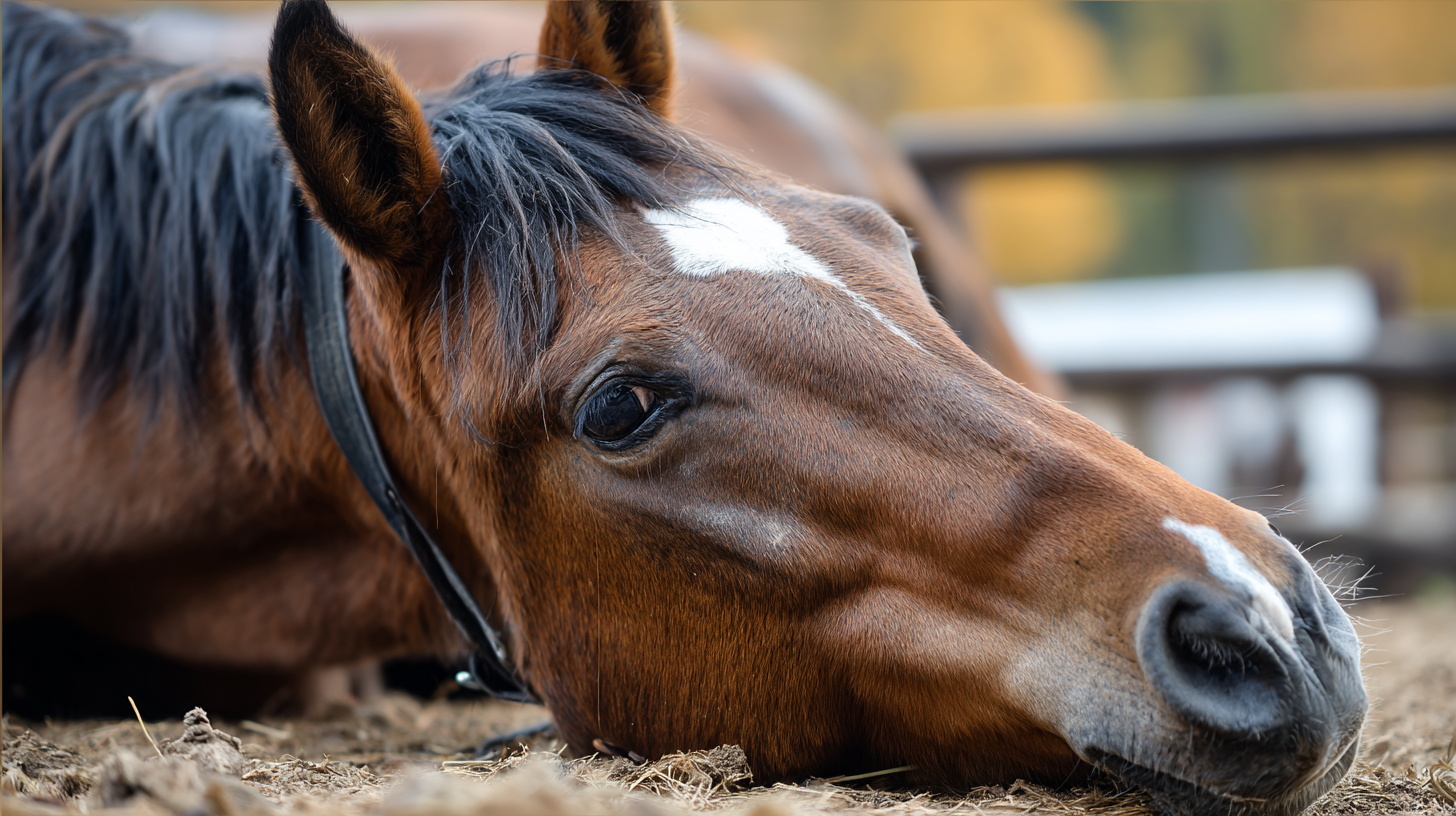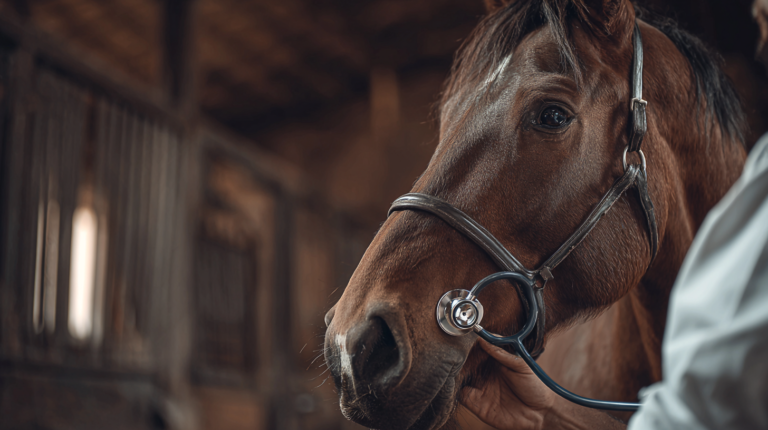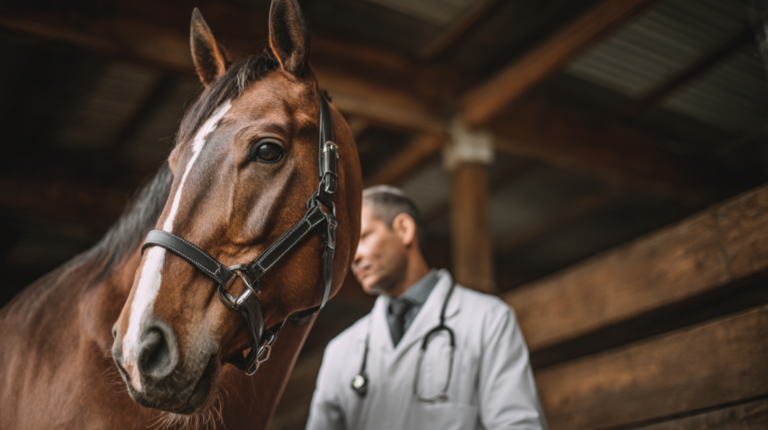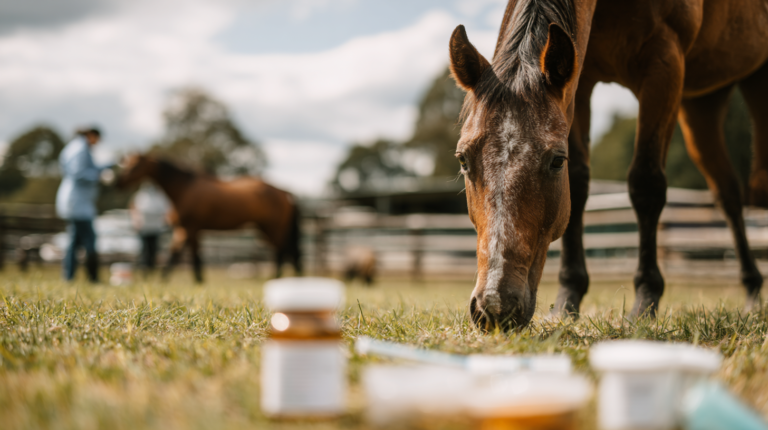Learn the 5 critical warning signs of poisoning in horses. Expert veterinary advice on symptoms, prevention, and emergency care for horse owners.
Table of Contents
Every horse owner’s worst nightmare is discovering their beloved companion has ingested something toxic. Poisoning in horses represents one of the most serious emergency situations in equine care, often developing rapidly and requiring immediate veterinary intervention. Unlike smaller animals, horses cannot vomit, making toxic ingestion particularly dangerous as harmful substances remain in their system longer.
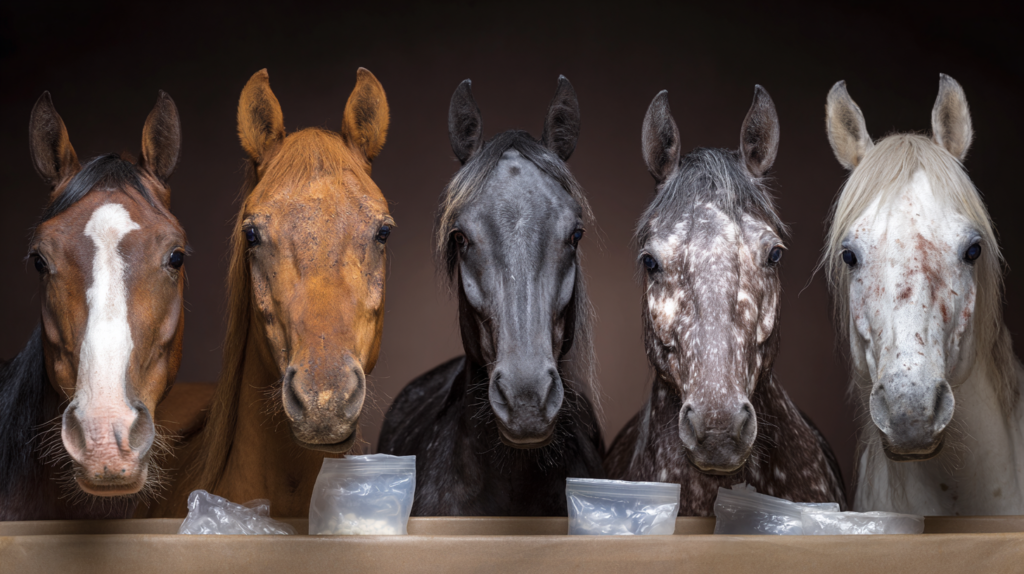
According to the American Association of Equine Practitioners (AAEP), plant toxicities alone account for approximately 3-5% of all equine emergency calls, with many cases going unreported due to delayed recognition of symptoms. The sheer size of horses means they can consume large quantities of toxic materials before owners notice, and their unique digestive system makes them especially vulnerable to certain poisonous substances.
Understanding the warning signs of poisoning in horses can mean the difference between life and death for your equine companion. This comprehensive guide will equip you with the knowledge to recognize dangerous symptoms, take immediate action, and potentially save your horse’s life.
| Toxic Substance | Source | Onset Time | Primary Symptoms | Severity Level |
|---|---|---|---|---|
| Wild Cherry (Cyanide) | Wilted cherry leaves, bark | Minutes to hours | Difficulty breathing, bright red gums, collapse | High |
| Ragwort | Yellow flowering weed | Weeks to months | Liver damage, weight loss, neurological signs | High |
| Red Maple Leaves | Wilted maple leaves | 18-24 hours | Dark urine, anemia, weakness | High |
| Oleander | Ornamental shrub | 2-6 hours | Heart arrhythmias, colic, tremors | High |
| Yew | Evergreen shrub | 1-3 hours | Sudden death, heart failure, trembling | High |
| Black Walnut | Wood shavings in bedding | 8-12 hours | Laminitis, swelling, increased temperature | Moderate |
| Bracken Fern | Wild fern plants | Weeks | Vitamin B1 deficiency, neurological symptoms | Moderate |
| Ionophore Antibiotics | Contaminated feed | Hours to days | Heart damage, muscle weakness, sweating | Variable |
| Buttercup | Yellow wildflower | 1-6 hours | Mouth irritation, colic, diarrhea | Moderate |
| Johnson/Sudan Grass | Drought-stressed grass | Hours | Cyanide poisoning, breathing difficulty | High |
The Critical Nature of Equine Poisoning
Horses face unique challenges when it comes to toxic exposure. Their inability to vomit means that once a poisonous substance enters their digestive system, it continues through their body, often causing progressive damage. This physiological limitation makes early detection and rapid response absolutely crucial.
The equine digestive system processes food slowly, with material taking 48-72 hours to completely pass through. During this time, toxic substances can continue to be absorbed, causing cumulative damage to vital organs. Additionally, horses’ large body size means they often consume significant quantities of toxic materials before showing obvious symptoms.
Environmental factors compound these risks. Horses are naturally curious animals with a tendency to explore their surroundings with their mouths. Pasture management, stable cleanliness, and proper storage of potentially harmful substances become critical components of prevention.
Understanding Common Sources of Equine Poisoning
Before diving into the warning signs, it’s essential to understand where poisoning threats commonly originate. Knowledge of these sources helps horse owners implement better prevention strategies and recognize potential exposure scenarios.
Plant Toxicities
Toxic plants represent the most common source of poisoning in horses. Red maple leaves, particularly when wilted, contain compounds that destroy red blood cells, leading to severe anemia. Wild cherry trees produce cyanide compounds that interfere with cellular oxygen utilization. Oleander, often used in landscaping, contains cardiac glycosides that can cause fatal heart arrhythmias.
Ragwort and tansy pose particular challenges because they remain toxic even when dried in hay. These plants accumulate in the liver, causing progressive damage that may not become apparent until significant harm has occurred. Bracken fern contains thiaminase, which destroys vitamin B1, leading to neurological symptoms.
Feed-Related Toxins
Moldy or contaminated feed sources create serious poisoning risks. Aflatoxins from moldy corn or other grains can cause liver damage and immune system suppression. Botulism from improperly stored silage or round bales can result in progressive paralysis and death.
Ionophore antibiotics, commonly used in cattle and poultry feed, are extremely toxic to horses. Even small amounts can cause severe heart damage and death. This highlights the importance of preventing cross-contamination between different species’ feed supplies.
Chemical and Medication Poisoning
Accidental exposure to pesticides, herbicides, or cleaning chemicals can occur when horses access treated areas too soon after application. Medication errors, including overdoses of routine treatments or exposure to medications intended for other animals, represent another significant category of poisoning incidents.
Lead poisoning, while less common today, still occurs when horses access old paint, batteries, or contaminated soil. The cumulative nature of lead toxicity means that even small, repeated exposures can eventually cause serious health problems.
Warning Sign #1: Severe Abdominal Pain and Digestive Distress
The first and often most dramatic sign of poisoning in horses manifests as severe abdominal pain, commonly referred to as colic. However, poison-induced colic differs significantly from typical digestive upset in both intensity and presentation.
Horses experiencing toxic exposure often exhibit extreme restlessness, pawing at the ground, and attempting to lie down and roll. Unlike mechanical colic, which may come in waves, poisoning-related abdominal pain tends to be constant and progressive. The horse may sweat profusely, even in cool weather, and show signs of extreme distress.
Digestive symptoms accompanying the pain provide important clues. Diarrhea, particularly if bloody or unusually colored, suggests irritation of the intestinal lining by toxic substances. Conversely, complete cessation of manure production may indicate severe digestive system shutdown.
Dr. Sarah Mitchell, an equine internal medicine specialist with over 15 years of experience, notes: “The key difference in poisoning-related colic is the horse’s inability to find relief through normal position changes. They appear genuinely distressed rather than just uncomfortable, and the pain doesn’t respond to walking or other typical colic management techniques.”
Salivation patterns also change dramatically. Excessive drooling, particularly if the saliva appears foamy or discolored, suggests irritation of the mouth and throat tissues. Some toxins cause difficulty swallowing, leading to feed material or water accumulating in the mouth.
The horse’s appetite provides another critical indicator. Complete refusal to eat or drink, especially in a normally food-motivated horse, raises immediate red flags. This differs from simple digestive upset, where horses may still show interest in favorite treats or fresh water.
Temperature regulation becomes compromised as toxic substances affect the horse’s metabolic processes. The animal may develop fever or, conversely, experience hypothermia as their body struggles to maintain normal function.
Warning Sign #2: Neurological Symptoms and Behavioral Changes
Neurological manifestations of poisoning in horses can range from subtle behavioral changes to dramatic loss of coordination and consciousness. These symptoms often develop gradually, making early recognition challenging but crucial for successful treatment.
Changes in mental status represent early warning signs that many owners initially dismiss as simple fatigue or mood changes. The horse may appear unusually lethargic, showing little interest in their surroundings or failing to respond to familiar stimuli. Alternatively, some toxins cause hyperexcitability, with the horse appearing anxious, restless, or hypersensitive to sound and touch.
Coordination problems manifest as stumbling, difficulty turning, or an unsteady gait. The horse may drag their feet, cross their legs while walking, or appear to have difficulty judging distances. These symptoms indicate that toxic substances are affecting the nervous system’s ability to control muscle movement.
Head positioning often changes dramatically. The horse may hold their head unusually high or low, tilt it to one side, or show difficulty lifting it normally. Some toxins cause head pressing, where the horse pushes their head against walls or other solid objects, indicating increased intracranial pressure.
Seizure activity represents a severe neurological emergency. Seizures may begin as mild muscle twitching or facial spasms but can progress to full-body convulsions. Even brief seizure episodes indicate serious poisoning and require immediate veterinary intervention.
Visual disturbances manifest as bumping into objects, difficulty navigating familiar areas, or changes in pupil size and response to light. Some horses develop a characteristic “star gazing” posture, holding their head elevated and appearing to look upward continuously.
Breathing patterns may become irregular as the poisoning affects the brain’s respiratory control centers. The horse may breathe rapidly, slowly, or with obvious effort, indicating that vital functions are being compromised.
Warning Sign #3: Cardiovascular System Compromise
The cardiovascular system often bears the brunt of toxic exposure, with symptoms ranging from subtle heart rate changes to complete circulatory collapse. These signs can be particularly challenging to detect without specific knowledge of normal equine vital signs.
Heart rate abnormalities provide critical information about the horse’s condition. A normal resting heart rate for adult horses ranges from 28-40 beats per minute. Poisoning can cause dramatic increases, with rates exceeding 60-80 beats per minute, or dangerous decreases below 20 beats per minute.
Rhythm disturbances are equally concerning. The horse’s pulse may feel irregular, with skipped beats or periods of rapid, chaotic beating. Some toxins cause specific arrhythmias that can be fatal if not treated promptly.
Mucous membrane color changes dramatically with cardiovascular compromise. Normal pink gums may become pale, indicating poor circulation or anemia. Bright red membranes suggest inflammation or certain specific toxins. Blue or purple coloration indicates severe oxygen deprivation and represents a life-threatening emergency.
Capillary refill time increases significantly with circulatory problems. Pressing firmly on the gums should cause blanching, with color returning within 1-2 seconds. Delayed refill times of 3-4 seconds or longer indicate poor circulation.
Peripheral circulation changes become apparent in the extremities. The horse’s legs may feel unusually cold, or the digital pulses in the feet may become weak or absent. Some toxins cause the opposite effect, with strong, bounding pulses indicating cardiovascular stress.
Blood pressure changes, while difficult to measure in field conditions, manifest through other clinical signs. Weak pulse quality, prolonged capillary refill, and cold extremities all suggest low blood pressure, while strong, bounding pulses may indicate hypertension.
Edema formation represents another cardiovascular indicator. Fluid accumulation in the legs, belly, or around the eyes suggests that the heart’s pumping efficiency has been compromised by toxic substances.
Warning Sign #4: Respiratory Distress and Breathing Abnormalities
Respiratory symptoms in horse poisoning cases can develop from direct toxic effects on the lungs or secondary to cardiovascular compromise. These signs often progress rapidly and require immediate attention to prevent fatal outcomes.
Breathing rate changes provide immediate clues about the horse’s condition. Normal resting respiratory rates range from 8-12 breaths per minute. Poisoning can cause rates to increase dramatically, sometimes exceeding 40-50 breaths per minute, or decrease to dangerously low levels.
Breathing effort changes are equally significant. The horse may show obvious difficulty breathing, with exaggerated chest movements, nostril flaring, or the use of abdominal muscles to assist breathing. Some horses develop a characteristic “heave line” along their flanks as they struggle to exhale.
Nostril discharge patterns change with respiratory poisoning. Clear discharge may become bloody, thick, or unusually colored. Some toxins cause foamy discharge, while others produce thick, tenacious secretions that the horse has difficulty clearing.
Coughing frequency and character provide diagnostic information. A sudden onset of frequent, harsh coughing suggests irritation of the respiratory tract. Some horses develop a characteristic “honking” cough associated with specific toxins.
Postural changes indicate respiratory compromise. The horse may stand with their head and neck extended, elbows positioned away from their body, and nostrils flared in an effort to maximize air intake. This “saw-horse” stance indicates significant breathing difficulty.
Lung sounds, while requiring veterinary examination to assess properly, may change dramatically. Owners may notice unusual sounds during breathing, including wheezing, rattling, or abnormal silence in areas where breathing sounds should be audible.
Oxygen saturation changes manifest through mucous membrane color changes. Blue or purple coloration of the gums, tongue, or inner eyelids indicates severe oxygen deprivation and represents a life-threatening emergency requiring immediate intervention.
Warning Sign #5: Skin Changes and External Physical Symptoms
External physical changes often provide the most visible evidence of poisoning in horses, though these symptoms may develop more gradually than the internal signs. Understanding these external manifestations helps owners recognize poisoning even when other symptoms remain subtle.
Skin color changes can be dramatic and immediate. Jaundice, characterized by yellowing of the skin and mucous membranes, indicates liver damage from toxic substances. This change is most easily observed in the whites of the eyes and the pink areas of the gums.
Sweating patterns become abnormal with many types of poisoning. The horse may sweat profusely without exercise or in cool weather, indicating that their body’s temperature regulation has been compromised. Conversely, some toxins prevent normal sweating, leading to dangerous hyperthermia.
Skin sensitivity changes dramatically with certain poisonings. The horse may develop photosensitivity, showing severe sunburn-like reactions on white or light-colored areas of their body. This reaction can occur even with minimal sun exposure and may progress to painful blistering.
Hair coat changes may develop with chronic or severe poisoning. The coat may become dull, brittle, or begin falling out in patches. Some toxins cause changes in hair color or texture, particularly noticeable in areas that receive regular grooming.
Skin lesions can appear as raised bumps, areas of swelling, or open sores. These may be localized to areas of contact with toxic substances or generalized throughout the body, indicating systemic poisoning.
Hoof changes provide important diagnostic information. Growth rings, changes in hoof wall quality, or abnormal hoof growth patterns may indicate chronic poisoning. Some acute toxins cause founder-like symptoms with severe hoof pain and lameness.
| Warning Sign Category | Specific Symptoms | What to Look For | Urgency Level |
|---|---|---|---|
| 1. Abdominal Pain & Digestive Distress |
|
Horse showing continuous discomfort, looking at flanks, sweating from pain, abnormal posturing | Immediate |
| 2. Neurological Symptoms |
|
Changes in behavior, inability to walk straight, muscle twitching, altered mental state | Immediate |
| 3. Cardiovascular Compromise |
|
Heart rate above 60 bpm at rest, gum color changes, poor capillary refill time | Immediate |
| 4. Respiratory Distress |
|
Increased respiratory rate, difficulty breathing, using abdominal muscles to breathe | Immediate |
| 5. Skin & External Changes |
|
Profuse sweating without exercise, contact dermatitis, swollen legs or face, bright red or yellow gums | Urgent |
Immediate Emergency Response Protocol
When you suspect poisoning in horses, every minute counts. Having a structured response plan can save your horse’s life and provide veterinarians with crucial information for treatment decisions.
The first priority involves ensuring safety for both horse and handler. If you suspect plant poisoning, immediately remove the horse from the contaminated area. For chemical exposure, avoid direct contact with potentially toxic substances and ensure adequate ventilation in enclosed spaces.
Documentation becomes critical for successful treatment. Take photographs of any suspected toxic plants, chemicals, or feed sources. Note the time of exposure if known, the amount potentially consumed, and any symptoms observed. This information guides veterinary treatment decisions and can be lifesaving.
Contact your veterinarian immediately, even if symptoms seem mild. Describe the situation clearly, including suspected toxins, symptoms observed, and the horse’s current condition. Many veterinarians prefer to evaluate potential poisoning cases immediately rather than wait for symptoms to worsen.
Basic first aid measures can be implemented while waiting for veterinary care. Remove any remaining toxic material from the horse’s mouth if safely possible. Provide fresh water if the horse is conscious and able to swallow normally. Keep the horse calm and limit movement to prevent increased absorption of toxic substances.
Avoid inducing vomiting, as horses cannot vomit effectively and attempts to do so can cause additional complications. Similarly, avoid giving milk or other home remedies unless specifically directed by a veterinarian.
Prepare for veterinary arrival by gathering all potentially toxic materials, feed samples, and any documentation about the incident. Clear pathways to the horse and ensure adequate lighting for examination. Have someone available to assist with restraint if needed.
Prevention Strategies for Horse Owners
Preventing poisoning in horses requires vigilance, proper management, and regular evaluation of potential hazards. A comprehensive prevention program addresses all major sources of toxic exposure while maintaining practical management approaches.
Pasture management forms the foundation of poisoning prevention. Regular pasture walks should identify and remove toxic plants before they become hazardous. Pay particular attention to fence lines, areas around water sources, and recently disturbed soil where new plants may establish.
Seasonal awareness is crucial, as toxic plant risks change throughout the year. Spring brings fresh growth of many toxic plants, while fall presents hazards from wilted leaves and seed pods. Drought conditions increase risks as horses may consume plants they would normally avoid.
Feed quality control prevents the majority of feed-related poisoning incidents. Source feed from reputable suppliers, inspect all deliveries for mold or contamination, and store feed properly to prevent spoilage. Separate storage areas for different animals prevent cross-contamination with species-specific medications or feed additives.
Chemical storage and application protocols protect horses from accidental exposure. Store all chemicals in locked, well-ventilated areas away from feed and water sources. Follow label directions precisely for application timing and withdrawal periods. Maintain detailed records of all chemical applications.
Property maintenance includes regular inspection of fence lines, buildings, and equipment for lead paint, batteries, or other toxic materials. Remove or secure these items to prevent access. Pay particular attention to areas where horses may be confined during inclement weather.
| Time Frame | Phase | Required Actions | Diagnostic Tests | Treatment Priority |
|---|---|---|---|---|
| 0-15 minutes | Emergency Assessment |
|
Visual assessment of vital signs, basic neurological check | Life Support |
| 15-30 minutes | Initial Stabilization |
|
Temperature, pulse, respiration, mucous membrane color | Prevent Further Exposure |
| 30 minutes – 2 hours | Veterinary Intervention |
|
Blood work, complete blood count, chemistry panel, toxicology screen | Toxin Neutralization |
| 2-6 hours | Advanced Diagnostics |
|
Liver enzymes, kidney function, cardiac enzymes, urine analysis | Organ Protection |
| 6-24 hours | Intensive Monitoring |
|
Serial blood work, cardiac monitoring, neurological assessments | System Support |
| 24-72 hours | Recovery Assessment |
|
Follow-up blood work, organ function tests, behavioral assessment | Recovery Support |
| 3-30 days | Long-term Management |
|
Periodic health checks, organ function monitoring, behavioral evaluation | Prevention Focus |
Advanced Diagnostic Considerations
Modern veterinary medicine offers sophisticated diagnostic tools for identifying and managing poisoning in horses. Understanding these options helps owners make informed decisions about their horse’s care and prognosis.
Laboratory testing provides definitive identification of many toxic substances. Blood chemistry panels reveal organ damage patterns specific to different toxins. Complete blood counts identify anemia from red maple poisoning or other blood disorders. Specialized tests can identify specific plant alkaloids, heavy metals, or drug residues.
Imaging studies help assess internal organ damage from toxic exposure. Ultrasound examination can reveal liver damage, kidney problems, or intestinal abnormalities. Radiographs may identify metal objects or help assess lung damage from inhaled toxins.
Cardiac monitoring becomes crucial for horses with cardiovascular symptoms. Electrocardiograms can identify specific rhythm abnormalities associated with different toxins and guide treatment decisions. Continuous monitoring may be necessary for severely affected horses.
Liver function tests provide critical information about prognosis and treatment success. Serial testing helps monitor recovery and identify horses requiring more intensive therapy. Some toxins cause delayed liver damage that may not become apparent for days or weeks after exposure.
Genetic testing is becoming available for some inherited conditions that increase susceptibility to certain toxins. Understanding these predispositions can help owners implement more targeted prevention strategies.
Treatment Approaches and Prognosis
Treatment of poisoning in horses varies dramatically depending on the toxic substance involved, the amount consumed, and the time elapsed since exposure. Understanding treatment principles helps owners make informed decisions about their horse’s care.
Decontamination efforts focus on removing or neutralizing toxic substances. Activated charcoal can bind certain toxins in the digestive system, preventing further absorption. Gastric lavage may be performed in some cases, though this is technically challenging in horses. Specific antidotes exist for some toxins, such as atropine for organophosphate poisoning.
Supportive care often determines the ultimate outcome. Intravenous fluid therapy maintains hydration and supports kidney function. Anti-inflammatory medications reduce tissue damage and pain. Nutritional support may be necessary for horses unable to eat normally.
Organ-specific therapies address damage to vital systems. Liver protectants help preserve remaining liver function in cases of hepatotoxicity. Cardiac medications support heart function in horses with cardiovascular toxicity. Respiratory support may include oxygen therapy or mechanical ventilation in severe cases.
Prognosis depends on multiple factors, including the specific toxin involved, the amount consumed, the horse’s overall health, and the speed of treatment initiation. Some toxins cause rapid, severe damage with poor prognosis, while others allow for good recovery with appropriate treatment.
Recovery monitoring continues long after the acute poisoning episode. Regular blood work monitors organ function and identifies potential complications. Some horses require weeks or months of supportive care to achieve full recovery.
Long-term Management and Monitoring
Horses recovering from poisoning often require extended monitoring and management to prevent complications and ensure complete recovery. Understanding these needs helps owners provide appropriate care during the recovery period.
Dietary management becomes crucial during recovery. Easily digestible feeds reduce stress on damaged digestive systems. Probiotics may help restore normal gut flora after antibiotic therapy. Specialized diets may be necessary for horses with specific organ damage.
Exercise restriction prevents additional stress on recovering organ systems. Gradual return to work should be based on veterinary evaluation and may take weeks or months. Some horses with heart or lung damage may require permanent exercise limitations.
Regular veterinary monitoring identifies potential complications early. Blood work should be repeated at predetermined intervals to assess organ function recovery. Physical examinations help detect any developing problems.
Environmental modifications may be necessary to prevent re-exposure. This might include pasture changes, feed source modifications, or alterations to stable management practices. Some horses develop increased sensitivity to certain substances after poisoning episodes.
Frequently Asked Questions
Expert answers to your most important horse poisoning concerns
How quickly do poisoning symptoms appear in horses?
Can horses recover completely from poisoning?
Are certain horse breeds more susceptible to poisoning?
How can I make my pasture safer from toxic plants?
What should I keep in my first aid kit for poisoning emergencies?
Is activated charcoal safe to give to horses?
No matching questions found. Try different search terms.
For more expert pet care tips and product recommendations, visit BlithePet.com — your trusted source for pet wellness.
Conclusion
Recognizing the signs of poisoning in horses can mean the difference between life and death for your equine companion. The five critical warning signs—severe abdominal pain, neurological symptoms, cardiovascular compromise, respiratory distress, and skin changes—provide a framework for early detection and rapid response.
Remember that poisoning in horses often presents with multiple symptoms simultaneously, and the severity can escalate rapidly. Trust your instincts as a horse owner; if something seems wrong, don’t hesitate to contact your veterinarian immediately. Early intervention provides the best chance for successful treatment and full recovery.
Prevention remains the most effective strategy against equine poisoning. Regular pasture management, proper feed storage, careful chemical handling, and environmental awareness significantly reduce risks. However, when prevention fails, rapid recognition and appropriate response can save your horse’s life.
The investment in knowledge about poisoning recognition and prevention pays dividends in the safety and well-being of your horses. Stay informed, stay vigilant, and maintain strong relationships with qualified veterinary professionals who can provide expert guidance when emergencies arise.
Have a similar experience with your pet? Share it in the comments below!

